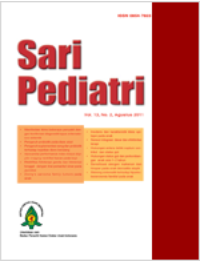Penggunaan Steroid dalam Tata Laksana Sepsis Analisis Kasus Berbasis Bukti
Sari
Sepsis merupakan salah satu penyebab kematian terbanyak di rumah sakit dengan mortalitas 50%-60%,
meskipun dengan terapi antibiotik dan tata laksana suportif yang adekuat. Steroid merupakan pilihan
terapi pada sepsis yang masih kontroversial sejak empatpuluh tahun yang lalu. Muncul pertanyaan klinis,
apakah pemberian steroid memberikan respon terapi lebih baik dan meningkatkan kesintasan pada sepsis
dibandingkan terapi konvensional? Ilustrasi kasus dan penelusuran kepustakaan menggunakan instrumen
pencari Pubmed, Highwire, dan Cochrane Library sesuai kata kunci.
Pada penelusuran didapatkan 16 artikel yang relevan 4 telaah sistematik, 9 uji klinis acak terkontrol, 1 kohort,
dan 2 review. Levels of evidence ditentukan berdasarkan klasifikasi Oxford atau Methodologic Quality
Form dari Cronin. Kortikosteroid dosis rendah jangka panjang sebaiknya diberikan pada semua syok septik
dependen vasopresor. Kortikosteroid tidak dianjurkan pada sepsis tanpa syok. Kortikosteroid dosis tinggi
dapat membahayakan pada sepsis berat dan syok septik. Steroid diberikan berdasarkan keputusan klinis,
bukan hasil laboratorium maupun protokol. Kortikosteroid memperbaiki keadaan syok septik persisten
dan lebih cepat memulihkan gangguan hemodinamik, sehingga menurunkan mortalitas
Kata Kunci
Teks Lengkap:
PDFReferensi
Angus D, Linde-Zwirble WT, Lidicker J, Clermont G,
Carcillo J, Pinsky MR. Epidemiology of severe sepsis in the
United States: analysis of incidence, outcome, and associated
costs of care. Crit Care Med 2001;29:1303-10.
Annane D, Aegerter P, Jars-Guincestre MC, Guidet B.
Current epidemiology of septic shock: the CUB-Réa
Network. Am J Resp Crit Care Med 2003;168:165-
Data Rekam Medis Departemen Ilmu Kesehatan Anak
Fakultas Kedokteran Universitas Indonesia – Rumah
Sakit Umum Pusat Nasional Cipto Mangunkusumo.
Diakses tanggal 6 November 2009.
Annane D, Cavaillon JM. Corticosteroids in sepsis: from
bench to bedside? Shock 2003;20:197-207.
Annane D, Sébille V, Troché G, Raphael JC, Gajdos P,
Bellissant E. A 3-level prognostic classification in septic
shock based on cortisol levels and cortisol response to
corticotrophin. JAMA 2000;283:1038-45.
Pizzaro CF, Troster EJ. Adrenal function in sepsis and
septic shock. J Pediatr (Rio J). 2007;83(5 Suppl):S155-
Oxford Centre of Evidence-based Medicine. Oxford
Centre for evidence-based medicine levels of evidence
(March 2009). Diunduh dari: http://www.cebm.net/index.
asox?o=1025. Diakses pada tanggal 1 Oktober 2009.
Cronin L, Cook DJ, Carlet J, Heyland DK, King D,
Lansang MA, dkk. Corticosteroid treatment for sepsis:
a critical appraisal and meta-analysis of the literature.
Crit Care Med 1995,23:1430-9.
Schumer W. Steroids in the treatment of clinical septic
shock. Ann Surg 1976;184:333-41.
Bone RC, Fisher CJJ, Clemmer TP, Slotman GJ, Metz
CA, Balk RA: A controlled clinical trial of high-dose
methylprednisolone in the treatment of severe sepsis and
septic shock. N Engl J Med 1987;317:653-8.
Veterans Administration Systemic Sepsis Cooperative
Study Group: Effect of high-dose glucocorticoid therapy
on mortality in patients with clinical signs of systemic
sepsis. N Engl J Med 1987;317:659-65.
Lefering R, Neugebauer EA. Steroid controversy in
sepsis and septic shock: a meta-analysis. Crit Care Med
;23:1294-303.
Annane D, Bellissant E, Sebille V, Lesieur O, Mathieu
B, Raphael JC, dkk. Impaired pressor sensitivity to
noradrenaline in septic shock patients with and without
impaired adrenal function reserve. Br J Clin Pharmacol
;46:589-97.
Bollaert PE, Charpentier C, Levy B, Debouverie M,
Audibert G, Larcan A. Reversal of late septic shock with
supraphysiologic doses of hydrocortisone. Crit Care Med
;26:645-50.
Briegel J, Forst H, Haller M, Schelling G, Kilger E,
Kuprat G, dkk. Stress doses of hydrocortisone reverse
hyperdynamic septic shock: a prospective, randomized,
double-blind, single-center study. Crit Care Med
;27:723-32.
Annane D, Sebille V, Charpentier C, Bollaert PE,
Francois B, Korach JM, dkk. Effect of treatment with low
doses of hydrocortisone and fludrocortisone on mortality
in patients with septic shock. JAMA 2002;288:862-
Annane D, Bellissant E, Bollaert PE, Briegel J, Keh
D, Kupfer Y. Corticosteroids for treating severe sepsis
and septic shock. Cochrane Database Syst Rev 2004;
:CD002243.
Dellinger RP, Carlet JM, Masur H, Gerlach H, Calandra
T, Cohen J, dkk. Surviving sepsis campaign guidelines
for management of severe sepsis and septic shock. Crit
Care Med. 2004;32:858-73.
Sprung CL, Annane D, Keh D, Moreno R, Singer M,
Freivogel K, dkk. Hydrocortisone therapy for patients
with septic shock. N Engl J Med 2008;358:111-24.
Finfer S. Corticosteroids in septic shock. N Engl J Med
;358:188-90.
Richardson L, Hunter S. Is steroid therapy ever benefit to
patients in the intensive care unit going into septic shock?
Interact CardioVasc Thorac Surg. 2008;7:898-905.
Dellinger RP, Levy MM, Carlet JM, Bion J, Parker
MM, Jaeschke M, dkk. Surviving sepsis campaign:
International guidelines for management of severe sepsis
and septic shock: 2008. Crit Care Med 2008;36:296-
Bone RC, Balk RA, Cerra FB. Definitions for sepsis and
organ failure and guidelines for the use of innovative
therapies in sepsis: the ACCP/SCCM Consensus
Conference Committee, American College of Chest
Physicians/ Society of Critical Care Medicine. Chest
;101:1644 –55.
Knighton JD, Woodock TE, Hough M. Adrenal failure
in the critically ill. Br J Anaesth 1999;82:152–3.
Cantani A. Malnutrition and the immune system.
Chapter 21. Dalam: Cantani A. Pediatric Allergy, Asthma
and Immunology. Berlin: Springer, 2008. h 1243-64.
Marik PE, Pastores SM, Annane D, Meduri GU, Sprung
CL, Arlt W, dkk. Recommendations for the diagnosis
and management of corticosteroid insufficiency in
critically ill adult patients: Consensus statements from
an international task force by the American College of
Critical Care Medicine. Crit Care Med 2008;36:1937-
DOI: http://dx.doi.org/10.14238/sp11.6.2010.387-94
Refbacks
- Saat ini tidak ada refbacks.
##submission.copyrightStatement##
##submission.license.cc.by-nc-sa4.footer##
Email: editorial [at] saripediatri.org


Sari Pediatri diterbitkan oleh Badan Penerbit Ikatan Dokter Anak Indonesia
Ciptaan disebarluaskan di bawah Lisensi Creative Commons Atribusi-NonKomersial-BerbagiSerupa 4.0 Internasional.




